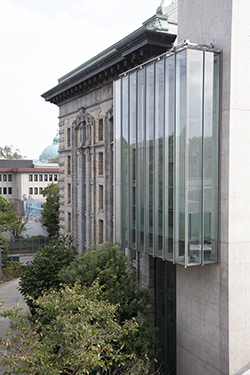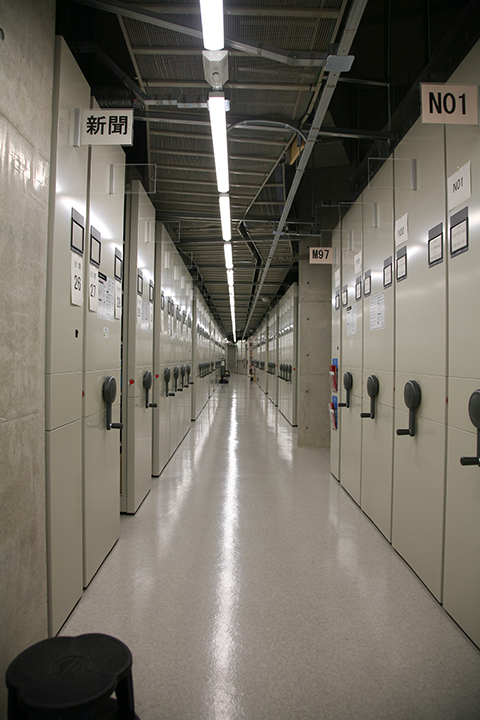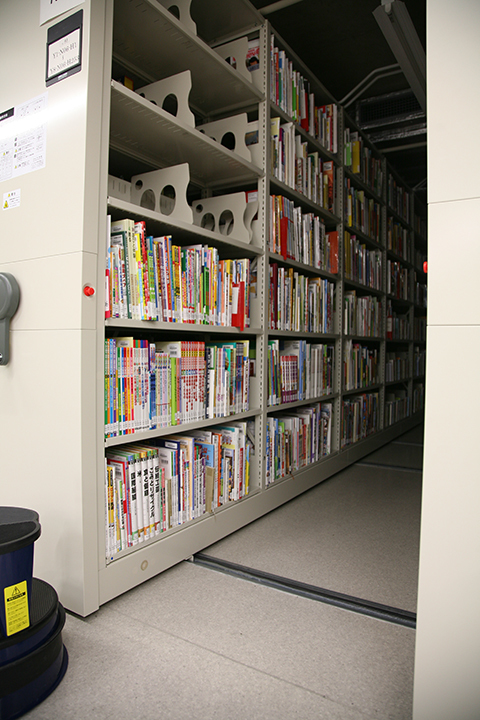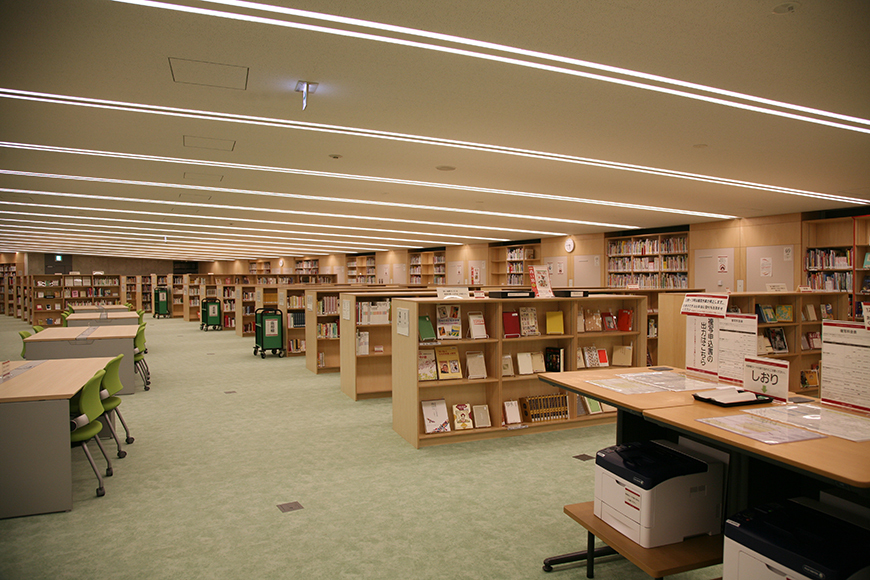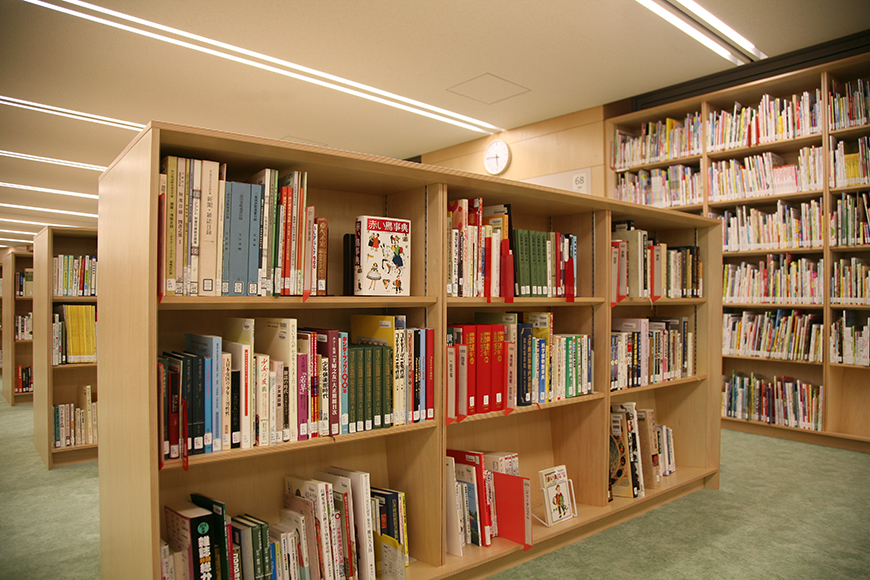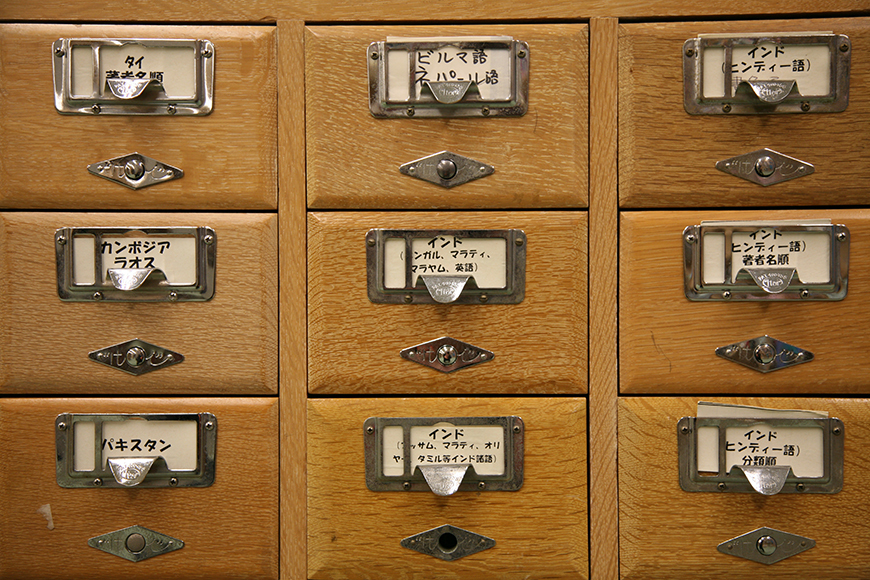Renovation for opening the International Library of Children's Literature
Q: How did you renovate the building when opening the International Library of Children's Literature?
Tadao Ando, an architect, and Nikken Sekkei thought hard about the renovation, and brought up the idea of covering the building with a glass structure.
The building of the former Imperial Library did not meet the current earthquake standards, so some measures for base isolation had to be implemented. Base-isolating devices, including a retrofit method, in which a base-isolating device is placed under the building, was implemented. First, those repairs were conducted in 2000.
Then, this building became cramped for space, so the arch-shaped new building was built in 2015.
Roles of the International Library of Children's Literature
Q: Could you tell me about roles of the International Library of Children's Literature?
Its mission is to support reading activities. Reading is a base for children to acquire various abilities to live in the future. It is also joy of life, so we want many children to know joy of reading. Therefore, we support those activities.
Especially, we bear in mind so-called division of roles between public and school libraries around the country and what we should do as the national library. We broadly group those roles into three categories. One thing is that it is the national library specialized in children's books. We have collected a variety of children's books from home and abroad. Especially, we can acquire domestic materials through the legal deposit system of the National Diet Library, so we have collected and stored those materials, and provided them to people who need them. Moreover, we have conducted investigations and researches based on those materials, and held lecture meetings, symposia and training sessions in collaboration with external specialists. Those activities are intended to support adults, including school teachers, librarians in public libraries, scholars of children's literature, and, as a matter of course, parents of children, who are doing activities to hand over books to children, instead of directly providing services to children. We support them in hope that services are indirectly provided to children throughout the country through services to adults who hand over books to children.
Another thing is that we have held events, such as a storytelling event, as indirect services to children. In recent years, we think that we should also enhance services for junior high and high school students. According to recent surveys, especially high school students' tendency to read books less is getting worse, so we bear in mind themes of how students know joy of reading and how to use a library, and have just started a program in which participants can have experience of researching in a library. We have striven to enhance services by trial and error.
The International Library of Children's Literature has another role. The library also serves as a museum, which is a characteristic of it. "Book Museum" is set up on the third floor in the brick building, and themed exhibitions are held about four times in a year. Since this year (2018) is the centennial of "Akai-tori," a magazine for children, first published in 1918, a commemorative exhibition is being held. Also, a permanent exhibition of children's books is being held in a room called "Gallery of Children's Literature" so that a history of children's books and picture books in Japan can be figured out. We hope that many people know charms of children's books through those exhibitions.
Q: Do you also try to reissue "Akai-tori"?
The International Library of Children's Literature does not reissue any books. However, we own many old original materials, so we exhibit many of those in exhibitions.
Q: Is there another national, children's library?
The International Library of Children's Literature is the only library in Japan. Looking at foreign countries, besides national, children's libraries, there are many libraries specialized in children's books, which are positioned as regional centers other than national ones, mainly in advanced countries. For example, the International Youth Library in Munich, Germany, is famous. It was the model of the International Library of Children's Literature when it was built. That library is operated with funds provided by the Cabinet of Germany, the Free State of Bavaria, and Munich. Also, in this library, direct services to children as well as investigations and researches, and services to support adults who hand over books to children are enhanced, and many researchers gather here.
There is also a center of children's books in the Library of Congress in the United States. Although it does not directly provide services to children, it collects information about children's books, and provide special knowledge and materials to adults who are involved in children's books not only in the United States but the world.
Cooperation with other organizations
Q: Do you cooperate with regional facilities and organizations in Japan?
Although they are mainly in Tokyo other than regions, we have emphasized cooperation with external organizations. We have worked closely with organizations related to children's books and specialists. Also, we meet them on a routine basis as much as possible, study with them, and jointly hold lecture meetings. We also participate in study meetings held by other organizations, and mingle with them.
Q: Are you also aligned with overseas organizations?
Yes, we are. As the name, "International" Library of Children's Literature, suggests, we place great emphasis on cooperation with foreign organizations, and form partnership with a variety of organizations. We also invite specialists from overseas libraries specialized in children's books, and hold their lectures. A chief librarian of the International Youth Library in Munich also came to this library, and delivered a lecture in early 2018. On the other hand, there is an organization called the International Board on Books for Young People (IBBY), in which many people involved in children's books and scholars of children's literature throughout the world take part. We also value cooperation with this organization. IBBY have awarded a prize called the Hans Christian Andersen Awards at the biennial IBBY Congress. This year, Eiko Kadono received the prize. We make sure to attend the IBBY Congress every time.
Q: How many books do you have?
We have 400,000 books. There is a total of 600,000 items, including books, CD, DVD and others. (continued in the right column)
Q: What kind of people come to the library?
Although it is the library for children, as I mentioned before, we have a purpose to support adults who hand over books to children, so according to a questionnaire result, the largest group of visitors is surprisingly people in their 40s, and they account for about 20%.
Q: Does it mean that many of them are leaders?
They are researchers, librarians and teachers in schools and so on. I think many of visitors are such people. The second largest group is teenagers, and they account for about 17%. So-called children aged 9 or under account for about 15%.
Q: What are the open hours?
The library opens from 9:30 to 17:00, closed on Mondays, and opens on Saturdays and Sundays as long as it is not a holiday. Although the library is closed on the third Wednesday every month in order to organize materials, it opens on Saturdays and Sundays so that children and their parents easily visit the library.
Q: Do many people come to the library after visiting Ueno Park?
There are both cases. Many people directly come to this library for the purpose of visiting it, but some people see the building of the library, and have an interest in it while visiting and strolling in Ueno Park so they come to the library. Recently, quite a lot of foreign tourists come to the library.
Q: Is the library well known to overseas people?
I think although not so many foreigners know our organization, some of them see the building, and have an interest in it because it looks beautiful, so they come to the library.
Q: Do you want to increase visitors from abroad?
Yes. We definitely want them to come to this library. The name of the library is the International Library of Children's Literature, so we want a wide variety of people to come to the library.
Q: Finally, could you say a brief word?
I said this library attaches importance to services for not only children but adults. Books that have been provided to children and withstood the test of time for a long time are also enjoyable for adults to read. I want as many people as possible to know charms of such children's books. I think people who properly read books in their childhood can naturally acquire abilities to enrich their lives.
We recently put a lot of effort into publicity, and want people to know various aspects of this organization. We have also taken over the wonderful building, so we want people to know its appeals, and take that opportunity to have an interest in the International Library of Children's Literature.
Also, in recent years, it is said that especially services for junior high and high school students are important, so we, as the International Library of Children's Literature, would like to contribute to the services as much as possible. We will appreciate your support and help.
